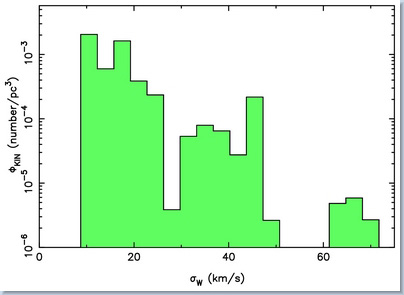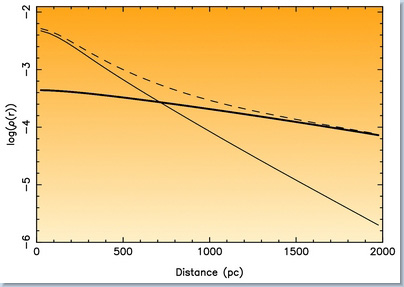|
The knowledge of the kinematical structure of the Milky Way disk is an
important constraint on how the Galaxy has been formed. While there is
common consensus that the disk of the Galaxy consists of two components -
the thin and the thick disk - the structure of the thick disk is not well
known. Scale heights range from 700 pc (Cabrera-Lavers et al. 2005) to 1500
pc (Gilmore & Reid 1983). Also the relation between the thin and the disk is
not clear. The stellar density distribution shows a change of slope in the
logarithm of the vertical distribution. But, is there a continuous
transition or a clear separation?
The combination of the photometric and kinematic informations can help to
answer this question in identifying more precisely the thin and thick disk.
In the past, such studies were limited to some specific directions. Now, all
sky survey like 2MASS
for photometry, the UCAC2
for proper motions and
RAVE
for radial velocities give global vision of the Galaxy. To describe these
new and accurate data, we have developed a self-consistent dynamical model.
The principal challenge of this models is the number of free parameters. Our
model is not limited to two characteristic velocity dispersions one for thin
disk and the other for the thick disk. Instead, a range of possible velocity
dispersions has been used. The Galactic disk is, in this way, decomposed in
kinematic components.
It appears that there is a clear kinematic discontinuity in the kinematical
decomposition (Figure 1). There are two mains features with vertical velocity
dispersion sigma_W = [10-25] km/s and sigma_W = [30-45] km/s that can be
recognized as the thin and thick disk. This proves that the thin and thick
disk are indeed two distinct components of the Galactic disk. With this
decomposition, a scale height of 220 pc for the thin disk and 1030 pc for
the thick disk has been measured (Figure 2). The kinematic identification of
the thin and thick disk links those structures to physical process of the
formation of the disk.
Moreover, this kinematical discontinuity between the thin and thick disk put
some constrains on the formation process of the Galactic disk. Scenarios
with a thick disk which would be a heated thin disk by molecular clouds or
spiral arms can be rejected. Other scenarios, e.g., in which the thick disk
is created by accretion events are compatible with our findings.
Reference
Veltz, L., Bienaymé, O., Freeman, K.C., Binney, J., Bland-Hawthorn, J., Gibson, B.K., Gilmore, G., Grebel, E.K., Helmi, A., Munari,
U., Navarro, J.F., Parker, Q.A., Seabroke, G.M., Siebert, A., Steinmetz, M., Watson, F.G., Williams, M., Wyse, R.F.G., Zwitter, T.:
Galactic kinematics with RAVE data: I. The distribution of stars
towards the Galactic poles. Astronomy and Astrophysics 480 (2008), 753.
Contact
Dr. Lionel Veltz
Astrophysikalisches Institut Potsdam
An der Sternwarte 16
D-14482 Potsdam
(0331) 7499 531

|
|

Figure 1: The local sigma_W kinematic distribution function: a thin disk component (sigam_W = [10-25] km/s) and a thick disk (sigam_W = [30-45] km/s).

Figure 2: Model of the vertical stellar density rho(z) (dashed line) and its thin and thick disk decomposition (respectively thin and thick lines).
|
[Galaxies program]
[AIP home page]
|
|


 last change 2008 March 26, R. Arlt
last change 2008 March 26, R. Arlt


